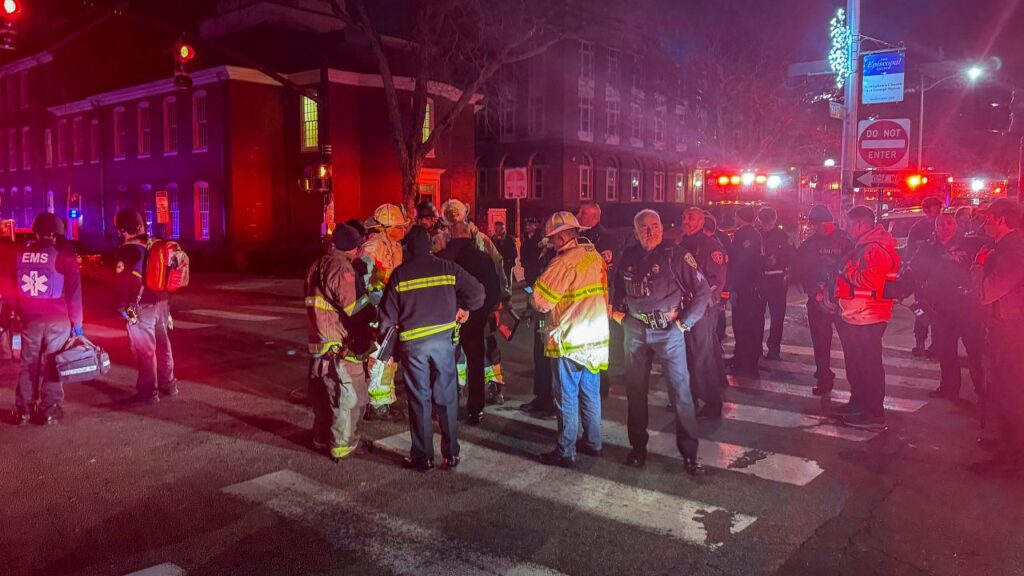Share
SLIPPERY ROCK, Pa. — President Donald Trump’s campaign has a bold theory for how he will win reelection: It can tap a universe of millions of supporters who did not vote for him in 2016 but will do so this time.
Supposedly, these voters are overlooked by polls that show Trump consistently trailing Democrat Joe Biden. They are mostly the white working class from factory towns, farms and mining communities that Trump has elevated to near-mythic status as the “forgotten Americans.”
They are disaffected and disconnected from conventional politics. Yet they flock to the Republican president’s rallies, plaster their yards with signs and have been filling up voter registration rolls, the campaign insists.
This strategy will be tested in Pennsylvania, a critical state that Trump carried by only 44,292 votes out of 6.1 million cast in 2016. A Democratic surge of votes in cities and suburbs could quickly erase that narrow lead. To hold onto Pennsylvania’s 20 electoral votes, the president needs to prove that a hidden groundswell of supporters exists — and will vote.
But the math behind the theory is tight. Trump’s plan requires blowout victories and historic turnout in conservative strongholds across the state, places where he outperformed traditional Republicans four years ago and he knows must do even better. His mission is made clear by his campaign stops in Pennsylvania this week — a tour through GOP areas like Latrobe, Lititz and Martinsburg,
“Trump has to drive turnout,” said Terry Madonna, a professor at Franklin & Marshall College in Lancaster who has conducted polls in the state for almost three decades. “I don’t see any evidence that he’s expanded his base.”
The strategy is more difficult to execute given the stunning disruption wrought by the coronavirus pandemic, both in terms of a public health crisis and nationwide economic dislocation.
Trump’s handling of the virus has cost him support among suburban women and older voters. His response to the civil unrest reacting to police killings of Black men only served to energize the resolve of Black women, as candidates and as voters. His wrecking-ball persona has prompted some of his backers in 2016 to reject him.
So his fate lies in large part in places like Butler County, an overwhelmingly white, conservative county north of Pittsburgh. There are nearly two Republicans for each registered Democrat. Most adults did not graduate from college. The economy rests on manufacturing and fracking, as well as service-sector jobs from suburbs creeping in from the city.
Republican turnout in Butler County was an impressive 80% in 2016. But local Republicans say the goal is to push that number as high as 90% this year. And they’ve spent several months registering new Republicans, adding 9,043 of them this year alone, for a 12.8% increase. Trump’s campaign is trying to replicate those kinds of numbers in other rural and exurban counties in the state.
Al Lindsay, a 74-year-old trial lawyer and farmer who leads the Butler County Republicans, says that registration push has been made easy by frustrations over pandemic lockdowns and a growing belief that Democrats don’t understand people who are religious and rural. His pitch is simple: “Look, there’s an urgency here. We need you.”
Republicans Have Been Operating Three Campaign Offices in the County
Butler wears its industrial past openly. There is still a baseball field at the historic Pullman Park, but the company closed its railcar factory in 1982. Its towns’ Main Streets recall an era when America was ascendant. The wire rope that holds up the Brooklyn Bridge was made in Butler County. So was the prototype for the Jeep deployed in World War II.
Republicans have been operating three campaign offices in the county — a declaration of their intention to dominate. Slippery Rock Mayor Jondavid Longo pushed to open one of those offices in his town of 3,600. It sits opposite North Country Brewing, the town’s second-largest employer after Slippery Rock University, where Longo, a former Marine infantryman, attended college.
Longo, 30, was elected mayor of Slippery Rock in 2017 by promising to keep taxes low and attract new businesses. The Republican knocked on 1,000 doors on the premise — similar to Trump’s — that the key to winning was finding people who had tired of politics.
His suits are tailored, his beard manicured and he drives entrepreneurs through Slippery Rock in a matte white Tesla. Trump “has given us an energy that says, Don’t back down, stand up for what’s right,” Longo said. “Open your mouth when you feel compelled to do so.”
The mayor has aimed to turn out younger voters, a group that normally favors Democrats. But in Butler County, there are almost twice as many Republicans under 35 as there are Democrats — and their perspectives veer from the politics of their peers across the country.
“Most dear to me, first and foremost, would be abortion — obviously, pro-life,” said Adam Jones, 19, a sophomore at Slippery Rock University who plans to cast his first vote for Trump. Behind that, Jones says, he prioritizes the Second Amendment and “resisting socialism.”
Tyler Good, 21, was a month too young to vote for Trump in 2016 and is among the Trump voters who’ve been added to the rolls. He’s a Baptist, works as a photocopier technician and hunts deer with a .270 Remington rifle. He says Trump is appealing because he broke the mold of what a president can be.
“He’s not a politician,” Good said. “He does get stuff done. He’s a businessman, you know. He doesn’t mess around, it seems.”
Republicans like Longo are also hunting for voters like Dane Patricelli, a 27-year-old construction worker who leans conservative but cast his ballot in 2016 for Libertarian Party candidate Gary Johnson.
Patricelli said Trump seemed like too much of a wild card in 2016. He wrestled for months with his decision this year, believing that Biden was a moderate even if the Democrats were drifting leftward. But he ultimately decided last week — after the last debate — that Trump had earned his vote.
“I do like Trump because he’s shaken things up and is not bought and paid for,” he said. “He’s sticking to his promises.”
But while Trump can tally up some first-time and third-party voters, he continues to lose Republicans like Lisa Barrickman.
At 52, she retired from working at a Walmart store and has seen Cranberry Township become part of Pittsburgh’s suburban sprawl. Barrickman said she voted Republican four years ago but can’t this time around.
“There is just too much division in this country,” she said. “If you’re a leader, you don’t incite, you quiet the storm. I know all politicians lie, cheat and scam — but it’s just too much to me. Biden — he’s calmer, he doesn’t spew with the hate.”

There Are Signs of Success
The Trump campaign has long known its best shot at winning was finding new voters in its strongholds, rather than persuading swing Democrats or independents. They used Trump’s raucous rallies in small towns and places that rarely get presidential attention to attract those voters to an unconventional campaign. They launched a voter registration and data collection effort around those events.
There are signs of success: In Florida, the party has registered 475,500 Republicans over the past four years, outpacing gains of 395,600 for Democrats. The campaign has claimed that as many as a quarter of attendees at rallies did not vote in 2016.
But in Pennsylvania, Democrats still outnumber Republicans by more than 700,000 registered voters, and there are an additional 1.3 million who are not associated with either party. And an Associated Press analysis of voting in key counties demonstrates the hurdles the GOP faces to overcome Democratic enthusiasm.
Butler County has 10,600 Republicans who were registered but did not vote in 2016. About 11% of them decided to cast a ballot in this year’s Republican primary, in which Trump ran unopposed, according to the analysis using data from L2, a political data firm. That’s a strong indicator that those voters are likely to vote again this year.
A similar pattern played out in 10 major Republican counties in Pennsylvania: Just over 10% of registered Republicans who sat out 2016 voted in the 2020 primary. That translates into nearly 14,000 voters.
The obstacle for Trump is that Democrats — they had a competitive presidential primary — have more voters and generated a better return rate. There are 258,000 Democrats who were registered but did not vote in Philadelphia and its surrounding counties in 2016. But during this year’s primary, more than 34,300 of them became voters and cast ballots. That’s more than double the gains in Republicans from the 10 leading Trump counties.
“For both campaigns, they’re seeing an acceleration of the trends we saw in 2016,” said Christopher Nicholas, a veteran Republican strategist. “Biden is doing better in the suburbs across the state. The Trump campaign is doing better in rural and exurban Pennsylvania.”
Democrats Are Engaged in Their Own Version of Hunting
While Democrats stopped most in-person campaigning as the virus peaked during the spring and summer, Republicans were quick to resume an aggressive ground game in Butler County as early as May. The campaign groomed “super volunteers” tasked with pushing turnout to a record, borrowing from the same playbook as Democrat Barack Obama’s 2008 campaign, said Brittney Robinson, director of the Trump campaign’s Pennsylvania operations.
Many of the Republican volunteers in Butler County are women, and their message is that Democrats just don’t understand parts of the country where schools close for the start of hunting season, said Trish Lindsay, the wife of the local party chairman as well as the vice-chair.
“It is the way of life that this election is about — and that is what is dividing people,” she said.
While the pandemic is often viewed as a millstone on the president’s popularity, Republicans here say it’s given Trump an extra push. His supporters said the restrictions set by Democratic Gov. Tom Wolf were an overreach that shuttered restaurants and hurt businesses. The issues motivating them include abortion, gun ownership and the continued fracking of natural gas — all areas where Trump has delivered for his base and Biden is perceived as a risk.
“You start with the proposition that most of the people here are very alienated by the Democratic Party,” explained Al Lindsay, the party chair and Trish’s husband. He was talking about politics while giving a tour of family land he once farmed — now a golf course where natural gas is being pumped from beneath the fairways.
Beyond cultural issues, he summarized his case directly: “We’re afraid that if the Biden ticket wins, that the gas and oil thing is going to be shut down.”
Democrats are engaged in their own version of hunting for that rare nonvoter who can be persuaded to turn out this time.
Catherine Lalonde, 59, wasn’t even registered as a Democrat in 2016, but the trained nurse now leads the Butler County party. She was unaffiliated and voted for Hillary Clinton in 2016, only to be stunned by her loss. The Democrats’ office — it didn’t exist in 2016 — is a hive of candidates and voters picking up signs in the morning to replace those damaged or stolen during the night.
Trump signs might dominate, but frustrated Democrats feel a new urgency about expressing themselves.
“Other years, people tended to be a little more cautious about putting up signs because they’re in a place with a Republican majority,” Lalonde said. “But this year, they feel they have to do it.”
But in Butler County, for every eager Democratic voter like Lalonde, there are more Republicans who are lining up to vote for Trump — and many believe that in this election, everything is at stake.
Bill Adams, 76, has long lamented the decline of U.S. manufacturing, having proudly opened up a suction-cup factory in Butler County after transitioning from work as an elementary school librarian. Adams is convinced the nation is at a precipice where Democrats would destroy businesses, if not personal freedom.
“I’ve never seen anything like it — we are where Venezuela was before the socialists took over,” he said. “That is the choice. It’s not what I think. It’s what history tells us.”
Trump will need many more like Adams if he is to win a second term.



















